Are you looking for a great coral that can jazz up your tank without being too difficult to care for? You might be in the market for a hammer coral, Euphyllia ancora. This popular large polyp stony coral species has all the right raw materials to make a great next coral for your tank–they build their own stony coral skeleton, have bold, beautiful, flowing polyps, are photosynthetic, can be fragged relatively easily, and will grow even faster if fed.
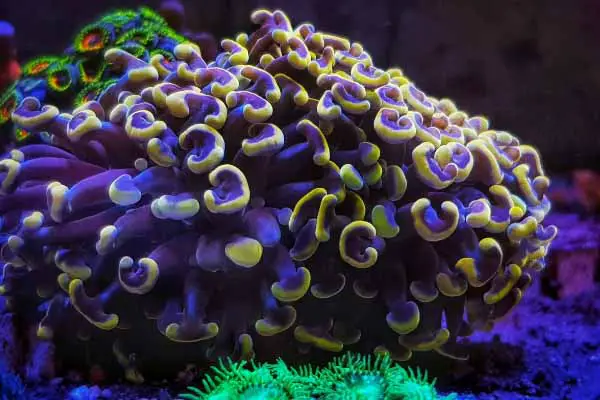
If you want to learn how to care for hammer corals in your tank correctly, then continue reading below!
Table of contents
- Quick care guide facts
- Natural habitat
- Proper aquarium conditions for hammer corals
- Placement
- Lighting
- Compatibility
- Fragging
- Feeding
- Are hammer corals easy to care for?
- Will a clownfish host a hammer coral?
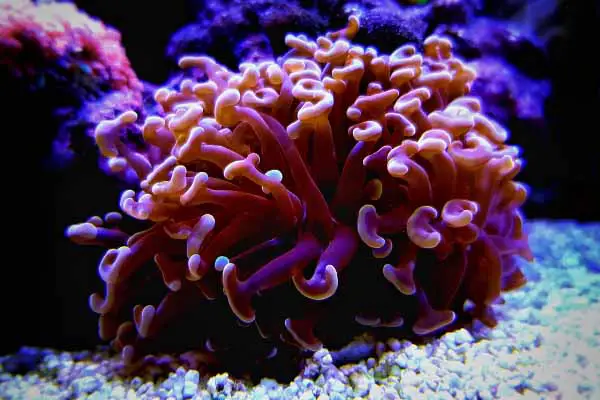
Quick Facts About the Hammer Coral
- Scientific Name: Euphyllia ancora
- Common Names: Anchor Coral
- Minimum Tank Size: 20-gallons
- Aggression Level: Aggressive – Hammer corals have sweeper tentacles that will sting neighboring corals
- Compatibility: Extremely compatible with other Euphyllia species (torch, frogspawn, etc.)
- Color: Gold, Green, Purple, Grey
- Care Level: Moderate
- Feeding recommended: yes, target feeding is recommended
- Calcium supplementation: yes, supplement to maintain calcium > 400 ppm
Natural Habitat
Hammer corals can be found in parts of the Indian and Pacific Ocean. In their natural habitat, E. ancora colonies can grow to be around a yard in size. Most colonies in the saltwater aquarium are considerably smaller. Unfortunately, the natural range has dramatically decreased in the past few decades and is categorized as vulnerable on the Endangered Species List.
The good news here, if there is any, is that the branching morph of this coral can be fragged quite easily, so wild collection should not be necessary.
Proper tank conditions for hammer corals
It takes a moderate level of skill to care for Hammer corals in a saltwater tank. Like most other coral species, Euphyllia ancora requires stable reef tank water conditions, is intolerant to major swings in water quality, and is sensitive to almost any level of copper in the water.

Since they are a large polyp stony coral, calcium and alkalinity are two very important water parameters that will affect the growth of your coral. This coral will start to die off if the calcium levels are too low. A calcium level of about 400 ppm is just right. Most hobbyists maintain sufficient calcium levels by:
- Measuring levels with a calcium test kit
- Using a high-quality salt mix
- Adding supplemental calcium as kalkwasser or 2-part
Give hammer corals some space to grow out and to keep them away from other corals. You can read more about why in the compatibility section.

Placement Where do you put a hammer coral in an aquarium?
Hammer corals generally do best when placed at the bottom of the tank, up to the middle in most reef tank systems. That assumes standard, strong reef aquarium lighting. If you have less intense lights, you should move the coral up in the water column accordingly.
This coral species isn’t terribly picky when it comes to the proper placement in your tank. The trick would really be just to avoid the extremes. Avoid extremely bright locations or areas of very high current. Those areas are best left to light-hungry SPS like the Birds Nest.
It is also best to avoid areas that are too dark or with currents that are too low. They generally require a bit more light than low like mushroom coral, or non-photosynthetic species like the ironically named Sun Coral, but not as much light as some other more light-hungry species.
Fast currents risk damaging the soft, fleshy polyps (and getting an infection). Bright lights will cause bleaching. Insufficient lighting will cause the poor coral to wither away and starve to death.
But that should leave you with a pretty wide footprint of suitable reef tank real estate in which to place them.
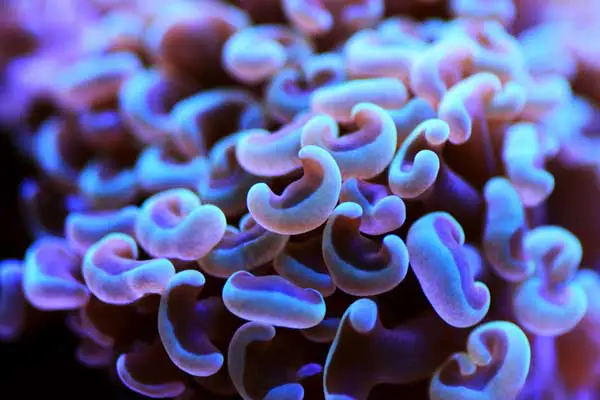
Lighting: How much light does a hammer coral need?
Hammer corals only require a moderate amount of light for photosynthesis and can grow well in the intermediate regions of your tank. That translates to about 80-120 PAR, as measured by a PAR meter, a tool that measures the photosynthetic quality of light.
Water flow
Moderate flow is the key. Think goldie locks and the three bears. Not too much, not too little, but just right. The polyps should sway in the current, but not sustain so much pressure they are constantly bent over their skeleton. Too much flow will tear the polyps (worst case) and cause the polyps to not extend in the first place (best case). So, don’t give them too much flow.

Compatibility
The hammer coral is considered to be an aggressive coral species that will attack its neighbors with sweeper tentacles. These are stinging nematocysts (similar to the sting of an anemone) on the end of a specialized polyp that can extend several inches away from the body of the coral. The sweeper tentacles pack a punch and will chemically burn any neighboring corals, even other LPS neighbors, like Favia, Acans, Blastos–that is if those aggressive corals don’t strike first.
So the rule of thumb is to give your hammer coral plenty of room–both to grow out and to keep them away from causing any trouble.
Interestingly enough, while this coral species is aggressive to other non-Euphyllia species, they typically can be kept closely with other Euphyllia corals (Frogspawn, Torch, Grape) without causing any problems. For this reason, many LPS coral lovers will keep multiple species of Euphyllia corals in the same tank.
You will want to avoid keeping this coral with any fishes or invertebrates known for nipping at corals, like butterflyfish, angelfishes, and rabbitfishes.

One final word of compatibility caution is with keeping them with the peppermint shrimp. There are some reports of these guys, often purchased because they’re willing to eat aiptasia anemones causing trouble for hammer and other fleshy polyped corals.
They are safe to keep with other reef-safe shrimp.
Reproduction & propagation (fragging)
While it is technically possible that your hammer corals could spawn in your tank, it is highly unlikely. However, if you have the branching variety in your tank, this coral, if healthy, will propagate by putting out additional branches.
You can snap, break, clip, or saw off those branches to “Frag it” and move part of the colony to another part of your tank or trade it to a friend, or to your local fish store for some store credit.
Just like pruning helps keep plants healthy, shaped properly, and growing away from harm, fragging does the same thing for your corals.
To learn more about coral fragging, download this book.
Feeding the hammer coral
All corals are animals. One thing animals have in common is that they tend to eat things. The hammer coral is no different there–but unlike some of the other LPS species, Euphyllia ancora is not an active, ravenous eater. Hammer corals are more subdued eaters who would benefit from the occasional feeding of a meaty marine food like mysis shrimp.
Feeding is fairly straightforward. Use Julian’s thing or a Sea Squirt feeder and push the soft, meaty food into the polyps. The coral may eat some of whatever your fish don’t steal away.

Where to buy Euphyllia ancora
Hammer corals are a staple in the saltwater aquarium trade and should be available at most local fish stores that cater to a saltwater aquarium audience. You can spend ~$20-40 on a frag, ~$75-$150 on a small colony, or hundreds of dollars on the most desirable color morphs.
When shopping for them, you want to see big, fat, fully-extended polyps and good coloration. Shy away from discolored (pale/white) colonies, or colonies with tightly retracted polyps, or those with their stringy innards hanging out.
This coral is also generally available on major online sites as well.
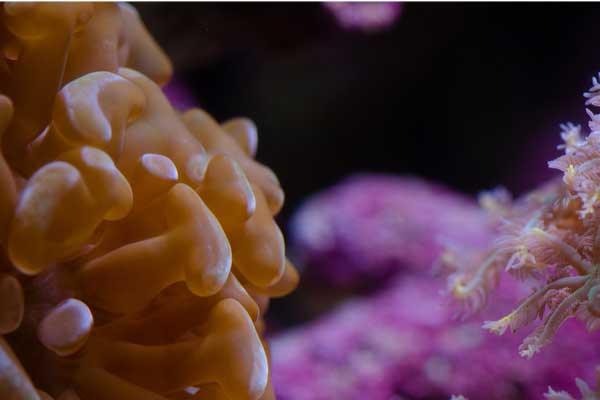
Are hammer corals easy to care for?
The hammer coral is a moderately challenging species to care for. The large and delicate polyps, the need for stable water parameters, moderate water flow, regular feedings, and the need to test for and maintain calcium levels above 400ppm puts these great corals in the category of moderate care level.
Will a clownfish host a hammer coral?
Clownfishes will often find an alternate host, like hammer corals or even a toadstool leather coral, if an anemone is not available. This can actually be the best of both worlds. You get to watch the natural behavior of the clownfish and you don’t have to have an anemone, which is often problematic.
Whether to buy a hammer coral or not
The hammer coral is a perfect coral for anyone with a moderate amount of reef aquarium success. Before trying this or any LPS coral species, I strongly recommend you start off caring for some of the bulletproof soft coral species first.
Once you’ve mastered caring for softies, the hammer coral is a perfect gateway coral to the land of stony corals, if you have space in your tank to add them, give them room to grow and still keep a safe distance from your other corals.
If you can meet this coral’s care requirements, you will be rewarded with a moderately easy to care for, a gorgeous addition to your tank that should hopefully grow and thrive for years to come.
Can you touch a hammer coral?
You can touch a hammer coral without being hurt, and you will need to handle them a little if you plan to move them in the tank or frag them. The best place to touch a hammer coral is on the stony skeleton below the polyps, to avoid damaging the polyps. In general, you should try to avoid touching the polyps, to avoid a potential sting for you and also to prevent accidental damage to the coral.
Do hammer corals like flow?
Hammer corals do best with a low-to-moderate amount of water flow. Enough to carry fresh, oxygenated water to the polyps without blowing them into their skeleton. Try to replicate a gentle breeze with the current.
Can you put two hammer corals together?
Hammer corals are peaceful towards other hammer corals and can be placed right next to each other without causing any aggression between the two. Hammer corals can also be safely kept together with other close members of the Euphyllia genus: Frogspawn, Torch and Grape corals.
It is perfectly safe for Other Euphyllia corals, like Torch corals, to touch a hammer.
Do you dip hammer coral?
It is generally best to dip all corals before placing them into your display tank, to help prevent adding harmful parasites to the system unintentionally. Coral dips work by agitating or killing the parasites so that they ‘jump off’ and show themselves before adding the coral. The smaller parasites cannot tolerate the dip as well or for as long as the corals.
For more information
If you want to learn more about other similar corals, check out:
- The torch coral and Frogspawn coral are fellow Euphyllia corals that will do well even adjacent to hammers
- Candy cane coral and Trumpet corals are popular and easy-to-care-for LPS
- Gonipora is another great LPS with large tentacles (that look like flowers)
Not ready for this coral yet? Check out these fantastic plating corals instead.

References:
Borneman, Eric H. Aquarium Corals. Microcosm Ltd; 1st Printing Edition (March 1, 2001)
Ulrich III, Albert B. How to Frag Corals: Step-by-step guide to coral propagation and filling your frag tank with thriving polyps.www.SaltwaterAquariumBlog.com (January 20, 2015).
Ulrich III, Albert B. The New Saltwater Aquarium Guide.www.SaltwaterAquariumBlog.com (April 8, 2014)

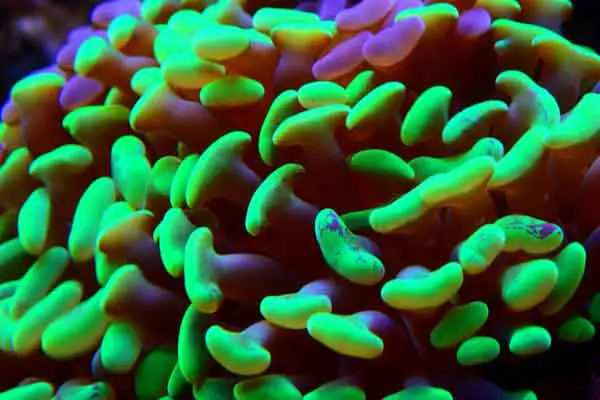
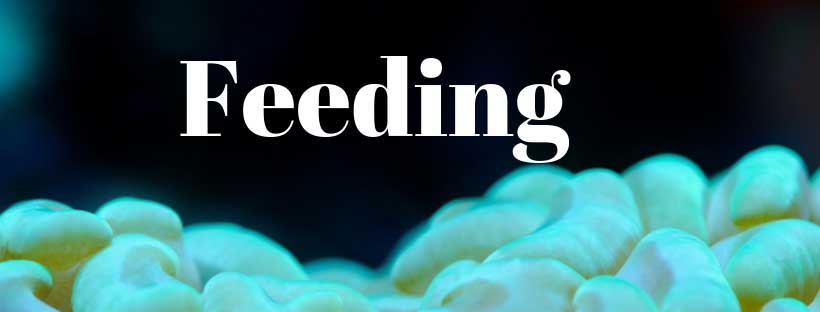
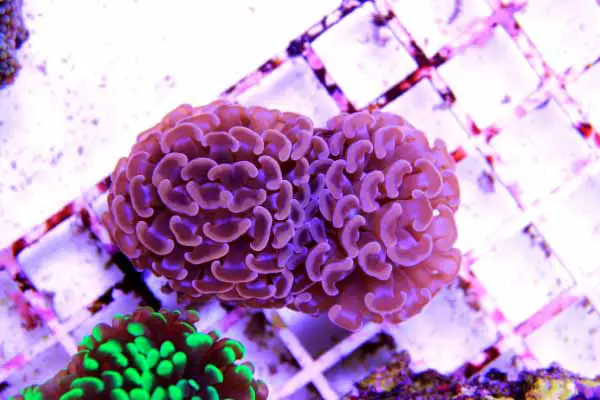

Leave a Reply